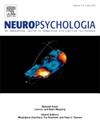Spatial and feature-selective attention interact to drive selective coding in frontoparietal cortex
IF 2
3区 心理学
Q3 BEHAVIORAL SCIENCES
引用次数: 0
Abstract
Attention enables the selective processing of relevant information. Two types of selective attention, spatial and feature-selective attention, have separable neural effects but in real life are often used together. Here, we asked how these types of attention interact to affect information coding in a frontoparietal ‘multiple-demand’ (MD) network, essential for attentional control. Using functional magnetic resonance imaging (fMRI) with multivariate pattern analysis, we examined how covert attention to object features (colour or shape) and spatial locations (left or right) influences coding of task-related stimulus information. We found that spatial and feature-selective attention interacted multiplicatively on information coding in MD and visual regions, such that there was above-chance decoding of the attended feature of the attended object and no detectable coding of visually equivalent but behaviourally irrelevant aspects of the visual display. The attended information had a multidimensional neural representation, with stimulus information (e.g., colour) and discrimination difficulty (distance from the categorical decision boundary) reflected in separate dimensions. Rather than boosting processing of whole objects or relevant features across space, our results suggest neural activity reflects precise tuning to relevant information, indicating a highly selective control process that codes behaviourally relevant information across multiple dimensions.
空间和特征选择性注意相互作用,驱动选择性编码在额顶叶皮层。
注意力使我们能够选择性地处理相关信息。空间选择性注意和特征选择性注意这两种类型的选择性注意具有可分离的神经效应,但在现实生活中经常同时使用。在这里,我们询问这些类型的注意力是如何相互作用以影响对注意力控制至关重要的额顶叶“多需求”(MD)网络中的信息编码的。利用功能磁共振成像(fMRI)和多变量模式分析,我们研究了对物体特征(颜色或形状)和空间位置(左或右)的隐蔽注意如何影响与任务相关的刺激信息编码。我们发现,空间和特征选择性注意在MD和视觉区域的信息编码上进行了多重交互,因此,对被关注对象的被关注特征进行了高于概率的解码,而对视觉显示中视觉等效但行为无关的方面没有可检测到的编码。参与的信息具有多维神经表征,刺激信息(如颜色)和辨别难度(与分类决策边界的距离)分别反映在不同的维度上。我们的研究结果表明,神经活动反映了对相关信息的精确调整,而不是促进整个物体或相关特征在空间中的处理,这表明一个高度选择性的控制过程,在多个维度上编码行为相关信息。
本文章由计算机程序翻译,如有差异,请以英文原文为准。
求助全文
约1分钟内获得全文
求助全文
来源期刊

Neuropsychologia
医学-行为科学
CiteScore
5.10
自引率
3.80%
发文量
228
审稿时长
4 months
期刊介绍:
Neuropsychologia is an international interdisciplinary journal devoted to experimental and theoretical contributions that advance understanding of human cognition and behavior from a neuroscience perspective. The journal will consider for publication studies that link brain function with cognitive processes, including attention and awareness, action and motor control, executive functions and cognitive control, memory, language, and emotion and social cognition.
 求助内容:
求助内容: 应助结果提醒方式:
应助结果提醒方式:


